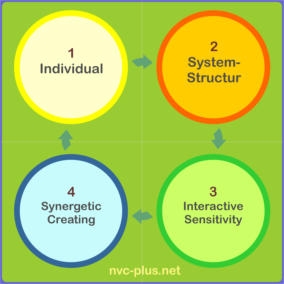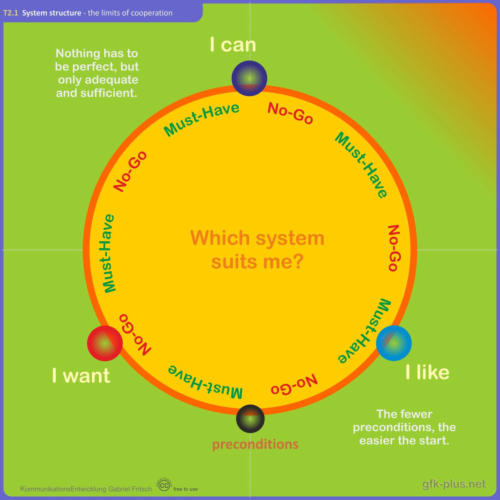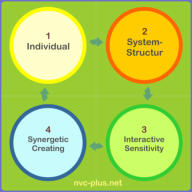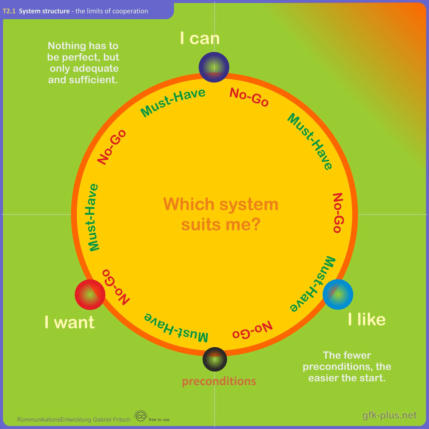

No-Goes and Must-Haves
Everyone
has
boundaries
that
are
difficult
to
cross.
These
boundaries
limit
our
joint
collaboration.
So
we
should
already
know
them
from
the
beginning
if
possible,
so
that
we
know
whether
we
even
have
enough
room
for
our
project
within
our
common
boundaries.
If
not,
we
have
already
failed
before
we
have
started
and
this
is
the
best
moment to do so.
At
NVC-plus,
we
don't
discuss
people's
boundaries
or
try
to
talk
them
down
and
declare
them
unimportant.
The
only
thing
we
can
try
to
do
is
to
specify
them
more
precisely
so
that
a
no-go
does
not
include
larger
areas
that
do
not
belong.
For
example,
if
someone
has
identified
fruit
salad
as
a
no-go,
then
we
can
ask
if
avocados
are
included
and
what
about
cucumbers
and
tomatoes.
Maybe
you
can
whip
up
something
tasty
after
all.
So
it's
about
communicating
and
accepting
boundaries.
But
it's
always
about
personal
boundaries.
It's
not
about
what
"you"
don't
do,
should
do,
or
must
do.
It's
about
what
overwhelms
me
or
you
and
what
I
need
and
you
need
to
be
there.
The
reasons
why
this
is
so
are
usually
not
important
and
you
can
almost
always
leave them out if you want to.
Toolcard T2.1
NVC-plus
has
some
toolcards
that
are
numbered.
Toolcard
2.1
is
the
first
toolcard
for
the
second
box
from
the
four-step
circle
(small
card
on
the
right).
This
tool
card
is
about
clarifying
whether
you
and
your
people
can
form
a
team
for
your
project
that
makes
sense.
You'll
collect
everyone's
no-goes
and
must-haves.
It
is
important
to
distinguish
the
"pain
points"
(Card
Z1)
from
the
no-goes
and
must-
haves.
Pain
points
are
unpleasant
but
bearable.
You
can
still
work
together
even
though
you
don't
like
something
or
something
goes
against
the
grain.
However,
everyone
has
some
real
limits
and
if
these
are
touched
by
the
common
project,
it
is
important
to
communicate
them
so
that
everyone
knows
whether
they
can
accept
the
limits
of
the
others
and
whether,
if
everyone
accepts
them,
there
are
still
possibilities
to
realize
the
intended
project.
This
should
be
done
at
the
very
beginning
of
the
project,
because
that
is
when
it
is
easiest
to
change
things
or
withdraw
from
the
project.
But
you
can
also
add
no-goes
and
must-haves
later
on.
At
the
beginning,
you
don't
know
how
everything
will
develop
and
over
time
you
get
wiser.
The
good
thing
is
that
for
many
no-goes
and
must-haves,
solutions
can
be
found
in
the
team
if
the
heart
forces
are
strong
enough,
or
come
into
play
strongly
enough
through
NVC
and
NVC-plus.
One
speaks
of
"taking
heart".
If
people
are
pretty
indifferent
to
each
other,
clarifying
the
no-
goes
and
must-haves
may
not
do
much
good.
And
if
they
don't
have
enough
peace
with
each
other,
they
should
first
resolve
the
conflicts
that
stand
in the way of peace - perhaps with classic NVC (Nonviolent Communication).

The map is part of a map set that you can find in the book, in the app or in the downloads.






Organising projects with self-organised teams

Everyone
has
boundaries
that
are
difficult
to
cross.
These
boundaries
limit
our
joint
collaboration.
So
we
should
already
know
them
from
the
beginning
if
possible,
so
that
we
know
whether
we
even
have
enough
room
for
our
project
within
our
common
boundaries.
If
not,
we
have
already
failed
before
we
have
started
and
this
is
the
best
moment
to
do
so.
At
NVC-plus,
we
don't
discuss
people's
boundaries
or
try
to
talk
them
down
and
declare
them
unimportant.
The
only
thing
we
can
try
to
do
is
to
specify
them
more
precisely
so
that
a
no-go
does
not
include
larger
areas
that
do
not
belong.
For
example,
if
someone
has
identified
fruit
salad
as
a
no-go,
then
we
can
ask
if
avocados
are
included
and
what
about
cucumbers
and
tomatoes.
Maybe
you
can
whip
up
something
tasty
after
all.
So
it's
about
communicating
and
accepting
boundaries.
But
it's
always
about
personal
boundaries.
It's
not
about
what
"you"
don't
do,
should
do,
or
must
do.
It's
about
what
overwhelms
me
or
you
and
what
I
need
and
you
need
to
be
there.
The
reasons
why
this
is
so
are
usually
not
important
and
you
can
almost always leave them out if you want to.
NVC-plus
has
some
toolcards
that
are
numbered.
Toolcard
2.1
is
the
first
toolcard
for
the
second
box
from
the
four-step
circle
(small
card
on
the
right).
This
tool
card
is
about
clarifying
whether
you
and
your
people
can
form
a
team
for
your
project
that
makes
sense.
You'll
collect
everyone's
no-goes
and
must-haves.
It
is
important
to
distinguish
the
"pain
points"
(Card
Z1)
from
the
no-goes
and
must-haves.
Pain
points
are
unpleasant
but
bearable.
You
can
still
work
together
even
though
you
don't
like
something
or
something
goes
against
the
grain.
However,
everyone
has
some
real
limits
and
if
these
are
touched
by
the
common
project,
it
is
important
to
communicate
them
so
that
everyone
knows
whether
they
can
accept
the
limits
of
the
others
and
whether,
if
everyone
accepts
them,
there
are
still
possibilities
to
realize
the
intended
project.
This
should
be
done
at
the
very
beginning
of
the
project,
because
that
is
when
it
is
easiest
to
change
things
or
withdraw
from
the
project.
But
you
can
also
add
no-goes
and
must-
haves
later
on.
At
the
beginning,
you
don't
know
how
everything
will
develop
and
over
time
you
get
wiser.
The
good
thing
is
that
for
many
no-goes
and
must-haves,
solutions
can
be
found
in
the
team
if
the
heart
forces
are
strong
enough,
or
come
into
play
strongly
enough
through
NVC
and
NVC-plus.
One
speaks
of
"taking
heart".
If
people
are
pretty
indifferent
to
each
other,
clarifying
the
no-goes
and
must-haves
may
not
do
much
good.
And
if
they
don't
have
enough
peace
with
each
other,
they
should
first
resolve
the
conflicts
that
stand
in
the
way
of
peace
-
perhaps
with
classic
NVC
(Nonviolent
Communication).
The
map
is
part
of
a
map
set
that
you
can
find
in
the book, in the app or in the downloads.




No-Goes and Must-Haves
Toolcard T2.1





Organising projects with self-organised teams


























